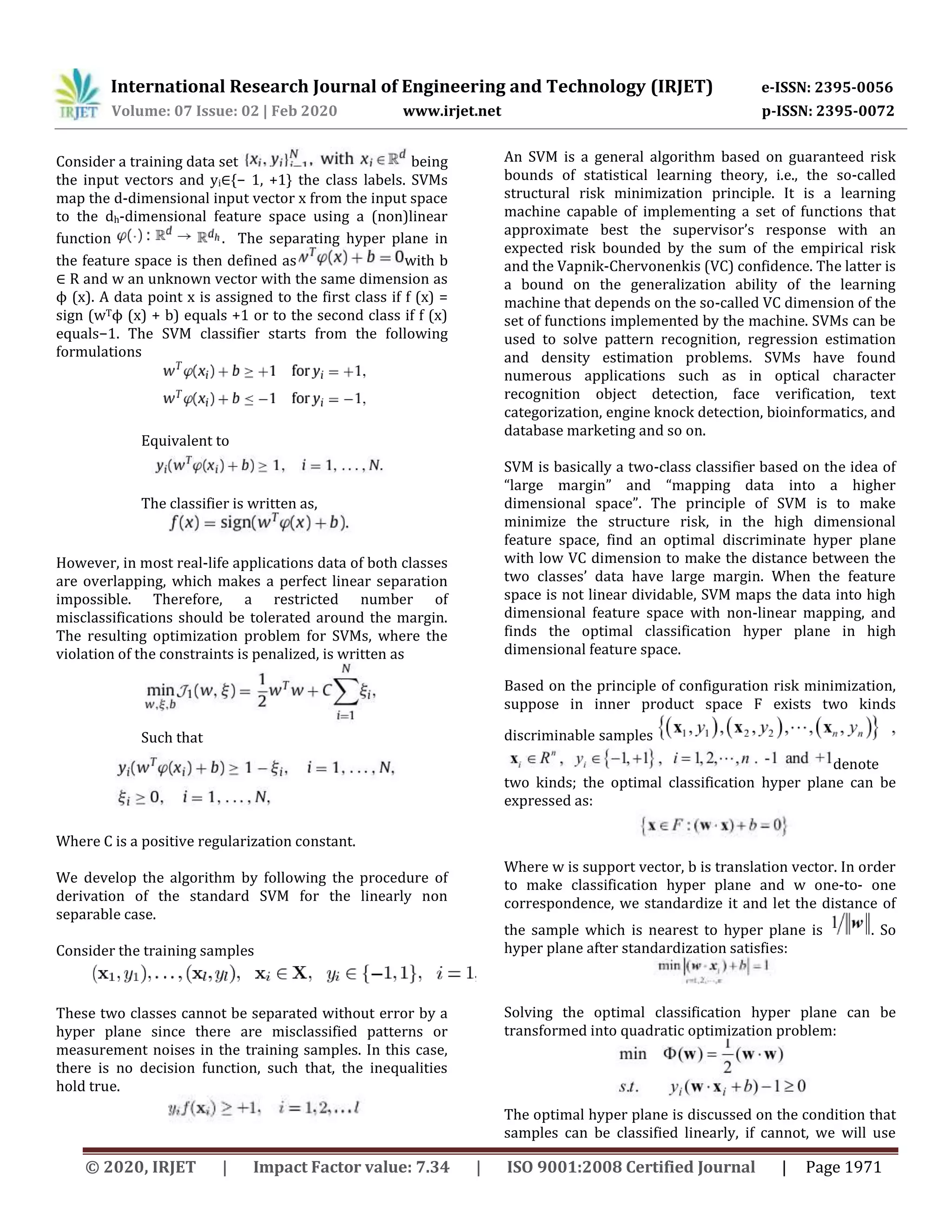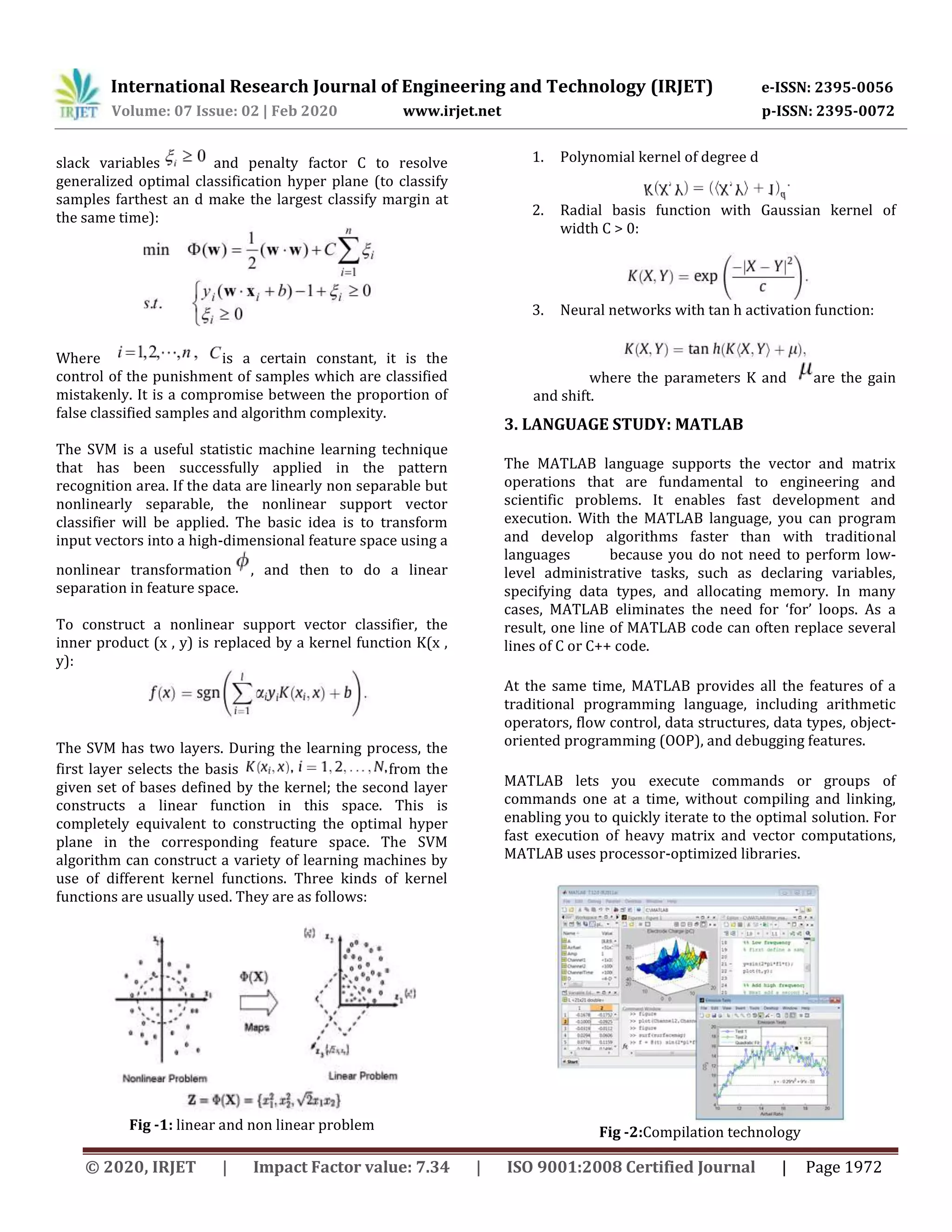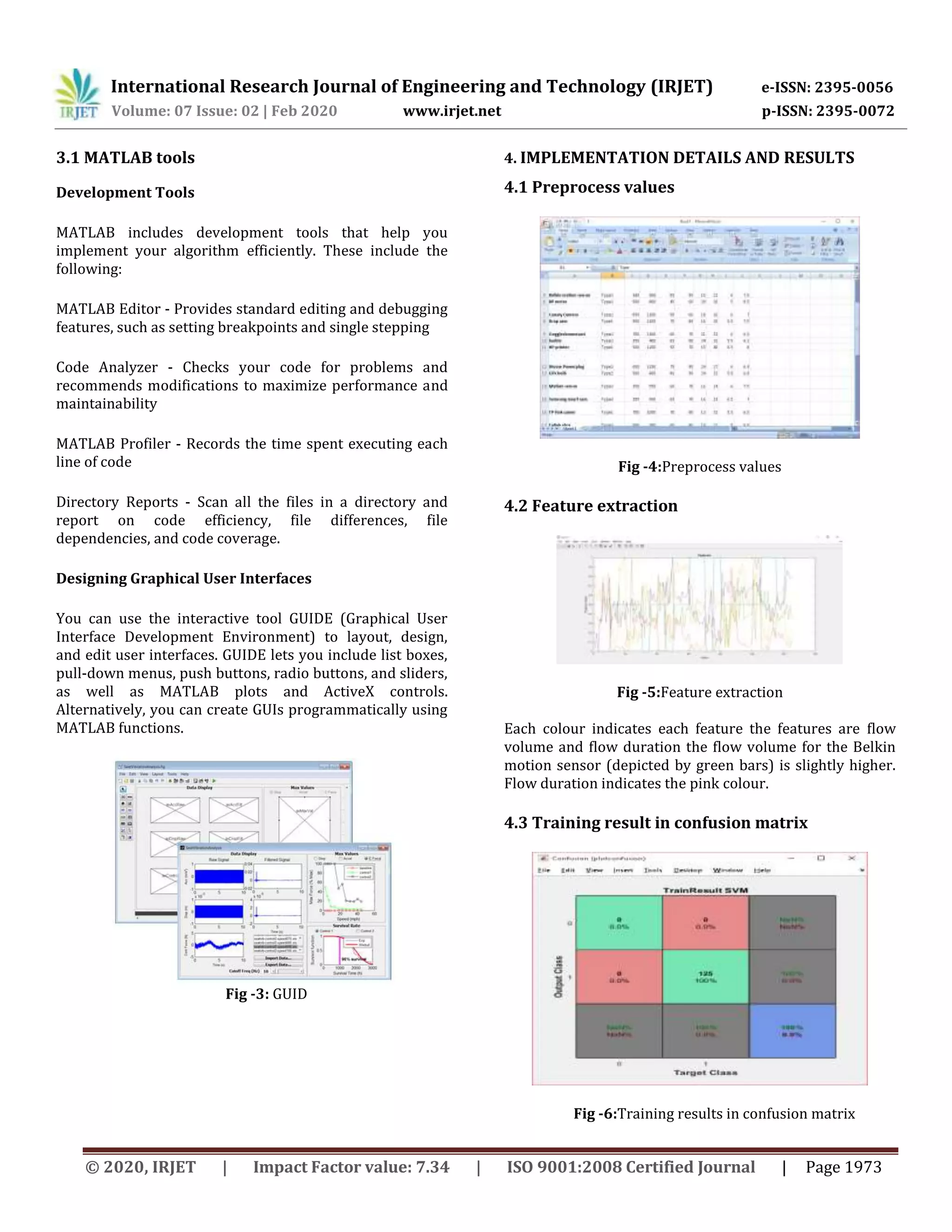This document presents a study on identifying and classifying Internet of Things (IoT) devices based on their network traffic characteristics using machine learning algorithms. The study involved collecting network traffic data from 28 different IoT devices over a period of 6 months. Statistical attributes like port numbers, domain names, and cipher suites were extracted from the traffic to analyze characteristics. A support vector machine (SVM) classifier was developed and shown to identify specific IoT devices with over 99% accuracy based on their network activity attributes. The study aims to help network operators monitor and manage IoT devices on their networks.
![International Research Journal of Engineering and Technology (IRJET) e-ISSN: 2395-0056
Volume: 07 Issue: 02 | Feb 2020 www.irjet.net p-ISSN: 2395-0072
© 2020, IRJET | Impact Factor value: 7.34 | ISO 9001:2008 Certified Journal | Page 1969
IDENTIFICATION AND CLASSIFICATION OF IoT DEVICES IN VARIOUS
APPLICATIONS USING TRAFFIC CHARACTERISTICS BY NETWORK LEVEL
BREEZY S1, Dr.P.KAVITHA2
1Student, Department of Computer Science and Engineering, P.S.R. Engineering College, Sivakasi, India.
2Professor, Department of Computer Science and Engineering, P.S.R. Engineering College, Sivakasi, India.
----------------------------------------------------------------------------***--------------------------------------------------------------------------
Abstract-The Internet of Things (IoT) is being hailed as
the next wave revolutionizing our society, and smart homes,
enterprises, and cities are increasingly being equipped with
a plethora of IoT devices. Yet, operators of such smart
environments may not even be fully aware of their IoT
assets, let alone whether each IoT device is functioning
properly safe from cyber-attacks.
First, I instrument a smart environment with 28 different
IoT devices spanning cameras, lights, plugs, motion sensors,
appliances and health-monitors. I collect and synthesize
traffic traces from this infrastructure for a period of 6
months, a subset of which I release as open data for the
community to use. Second, I present insights into the
underlying network traffic characteristics using statistical
attributes such as activity cycles, port numbers, signalling
patterns and cipher suites. Third, I develop a multi-stage
machine learning based classification algorithm and
demonstrate its ability to identify specific IoT devices with
over 99% accuracy based on their network activity.
Finally, I discuss the trade-offs between cost, speed, and
performance involved in deploying the classification
framework in real-time. My study paves the way for
operators of smart environments to monitor their IoT assets
for presence, functionality, and cyber-security without
requiring any specialized devices or protocols.
Key Words- IoT devices, Preprocess, Feature Extraction,
SVM Classifier.
1. INTRODUCTION
The number of devices connecting to the Internet is
ballooning, ushering in the era of the “Internet of Things”
(IoT). IoT refers to the tens of billions of low cost devices
that communicate with each other and with remote
servers on the Internet autonomously. It comprises
everyday objects such as lights, cameras, motion sensors,
door locks, thermostats, power switches and household
appliances, with shipments projected to reach nearly 20
billion by 2030. Thousands of IoT devices are expected to
find their way in homes, enterprises, campuses and cities
of the near future, engendering “smart” environments
benefiting our society and our lives. One would expect that
devices can be identified by their MAC address and DHCP
negotiation. However, this faces several challenges: (a) IoT
device manufacturers typically use NICs supplied by third-
party vendors, and hence the Organizationally Unique
Identifier (OUI) prefix of the MAC address may not convey
any information about the IoT device; (b) MAC addresses
can be spoofed by malicious devices; (c) many IoT devices
do not set the Host Name option in their DHCP requests;
indeed we found that about half the IoT devices we studied
do not reveal their hostnames; (d) even when the IoT
device exposes its hostname it may not always be
meaningful. For these reasons, relying on DHCP
infrastructure is not a viable solution to correctly identify
devices at scale [1].
This paper, we address the above problem by developing a
robust framework that classifies each IoT device
separately in addition to one class of non-IoT devices with
high accuracy using statistical attributes derived from
network traffic characteristics. Qualitatively, most IoT
devices are expected to send short bursts of data
sporadically. Quantitatively, our preliminary work in was
one of the first attempts to study how much traffic IoT
devices send in a burst and how long they idle between
activities. We also evaluated how much signalling they
perform (e.g. domain lookups using DNS or time
synchronization using NTP) in comparison to the data
traffic they generate[2]. This paper significantly expands
on our prior work by employing a more comprehensive set
of attributes on trace data captured over a much longer
duration (of 6 months) from a test-bed comprising 28
different IoT devices. There is no doubt that it is becoming
increasingly important to understand the nature of IoT
traffic. Doing so help unnecessary multicast/broadcast
traffic, reducing the impact they have on other
applications. It also enables operators of smart cities and
enterprises to dimension their networks for appropriate
performance levels in terms of reliability, loss, and latency
needed by environmental, health, or safety applications.
However, the most compelling reason for characterizing
IoT traffic is to detect and mitigate cyber security
attacks[3].](https://image.slidesharecdn.com/irjet-v7i2412-201123063114/75/IRJET-Identification-and-Classification-of-IoT-Devices-in-Various-Applications-Uusing-Traffic-Characteristics-by-Network-Level-1-2048.jpg)
![International Research Journal of Engineering and Technology (IRJET) e-ISSN: 2395-0056
Volume: 07 Issue: 02 | Feb 2020 www.irjet.net p-ISSN: 2395-0072
© 2020, IRJET | Impact Factor value: 7.34 | ISO 9001:2008 Certified Journal | Page 1970
It is widely known that IoT devices are by their nature and
design easy to in filtrate. New stories are emerging of how
IoT devices have been compromised and used to launch
large-scale attacks. The large heterogeneity in IoT devices
has led researchers to propose network-level security
mechanisms that analyze traffics patterns to identify
attacks, success of these approaches relies on a good
understanding of what “normal” IoT traffic profile looks
like. Our primary focus in this work is to establish a
machine learning framework based on various network
traffic characteristics to identify and classify the default
(i.e. baseline) behaviour of IoT devices on a network. Such
a framework can potentially be used in the future to detect
anomalous [4].
2. SYSTEM MODELING AND DESIGN
2.1 Modules
2.1.1 Preprocess
Preprocess, is a program that processes its input data to
produce output like a compiler. We identify key statistical
attributes such as port numbers, Domain Names and
cipher suites, and use them to give insights into the
underlying network traffic characteristics. For each device,
if a port is used more frequently then it is shown by a
larger font-size in the respective word cloud. It can be seen
that IoT devices each uniquely communicate with a
handful of server ports whereas non-IoT devices use a
much wider range of services. DNS is a common
application used by almost all networked devices. Domains
such as example.com, example.net, and example.org are
frequently requested by Amazon Echo, sub-domains of
hp.com and hpeprint.com are seen in DNS queries from the
HP printer. In order to initiate the TLS connection and
negotiate the security algorithms with servers, devices
start handshaking by sending a Client Hello packet with a
list of cipher suites that they can support, in the order of
their preference. The cipher suites that Amazon Echo
offers to two different Amazon servers. Each cipher suite
(i.e. 4-digit code) can take one of 380 possible values and
represents algorithms for key exchange, bulk encryption
and message authentication code (MAC). For example, the
cipher 002f negotiated by an Amazon server uses RSA, AES
128 CBC, and SHA protocols for key exchange, bulk
encryption and message authentication, respectively.
2.1.2 Feature Extraction
In Feature Extraction the IoT devices have the properties
of their traffic flows. We define two key attributes at a per-
flow level to characterize IoT devices based on their
network activity: flow volume (i.e. sum total of download
and upload bytes), flow duration (i.e. time between the
first and the last packet in a flow). The flow volume for the
Belkin motion sensor (depicted by green bars) is slightly
higher; over 35% of flows transfer between [2800, 3800]
bytes. For the Amazon Echo (depicted by blue bars), over
95% of flows transfer less than 1000 bytes. Though we
present the flow volume histogram for only a few devices,
most of our IoT devices exhibit a similar predictable
pattern. The flow duration 40% of flows for Amazon Echo,
while duration of 60 seconds is seen for the LiFX light bulb
and Belkin motion sensor with a probability of 50%
and21% respectively.
2.1.3 SVM Classifier
In machine learning, support vector machines (SVMs, also
support vector networks) are supervised learning models
with associated learning algorithms that analyze data used
for classification and regression analysis. Given a set of
training examples, each marked as belonging to one or the
other of two categories, an SVM training algorithm builds a
model that assigns new examples to one category or the
other, making it a non-probabilistic binary linear classifier.
We note that three of our attributes namely “set of domain
names”, “set of remote port numbers” and “set of cipher
suites” are nominal (i.e. are not treated as numeric values)
and multi-valued (for example, {”53”:3, ”123”:1, ”443”:2}
represents a set of remote port numbers with three
occurrences of port number 53, two occurrences of port
123, and one occurrence of port number 443). Our
remaining attributes including flow volume/duration and
DNS/NTP intervals contain single quantitative and
continuous values
.
2.1.4 Performance Analysis
In Performance Analysis we compare the existing system
with proposed system.
SVM classifier mechanism:
Support vector machines are supervised learning models
with associated learning algorithms that analyze data and
recognize patterns, used for classification and regression
analysis. The key concept of SVMs, which were originally
first developed for binary classification problems, is the
use of hyper planes to define decision boundaries
separating between data points of different classes. SVMs
are able to handle both simple, linear, classification tasks,
as well as more complex, i.e. nonlinear, classification
problems. Both separable and non separable problems are
handled by SVMs in the linear and nonlinear case. The idea
behind SVMs is to map the original data points from the
input space to a high-dimensional, or even infinite-
dimensional, feature space such that the classification
problem becomes simpler in the feature space.](https://image.slidesharecdn.com/irjet-v7i2412-201123063114/75/IRJET-Identification-and-Classification-of-IoT-Devices-in-Various-Applications-Uusing-Traffic-Characteristics-by-Network-Level-2-2048.jpg)



![International Research Journal of Engineering and Technology (IRJET) e-ISSN: 2395-0056
Volume: 07 Issue: 02 | Feb 2020 www.irjet.net p-ISSN: 2395-0072
© 2020, IRJET | Impact Factor value: 7.34 | ISO 9001:2008 Certified Journal | Page 1974
The above figure shows that the Support Vector Machine
Learning Algorithm that shows the result of both target
class results and output class result and finally its gives the
train result of SVM.
Fig -7: Performance Evaluation for Testing Data
In performance Analysis compares the Existing system
with Proposed System. In Existing System use the K-
Nearest Neighbor classification and the percentage of
accuracy, sensitivity, specificity, precision, recall,
Fmmeasure, Gmean is low and in proposed system use the
Support Vector Machine Learning Algorithm and the
percentage of accuracy, sensitivity, specificity, precision,
recall, Fmmeasure, Gmean is High.
5. CONCLUSION
Despite the proliferation of IoT devices in smart homes,
enterprises, campuses, and cities around the world,
operators of such environments lack visibility into what
IoT devices are connected to their networks, what their
traffic characteristics are, and whether the devices are
functioning appropriately free from security compromises.
This work is the first to systematically characterize and
classify IoT devices at run-time. We instrumented a smart
environment with 28 unique IoT devices and collected
traffic traces continuously over 26 weeks. We then
statistically characterized the traffic in terms of activity
cycles, signalling patterns, communication protocols and
cipher suites. We developed a multi-stage machine
learning based classification framework that uniquely
identifies IoT devices with over 99% accuracy. Finally,
We evaluated our method and compare it with Existing
System use the K-Nearest Neighbour and in proposed
system use the Support Vector Machine Learning
Algorithm and performance is high. the real-time
operational cost, speed, and accuracy trade-offs of our
classification method. This paper shows that IoT devices
can be identified with high accuracy based on their
network behaviour, and sets the stage for future work in
detecting misbehaviours resulting from security breaches
in tech smart environment.
REFERENCES
[1] I. Spectrum. (Last accessed July 2017.) Popular
Internet of Things forecast of 50 billion devices by
2020 is outdated. https://goo.gl/ 6wSUkk.
[2] Cisco, “Cisco 2017 Midyear Cyber security Report,”
Tech. Rep., 2017.
[3] A. Schiffer. (2017) How a fish tank helped hack a
casino. https: //goo.gl/SAHxCX.
[4] Ms. Smith. (2017) University attacked by its own
vending machines, smart light bulbs & 5,000 IoT
devices. https://goo.gl/ cdNJnE.
[5] S. Alexander and R. Droms, “DHCP Options and
BOOTP Vendor Extensions,” Internet Requests for
Comments, RFC Editor, RFC 2132, March 1997.
[Online]. Available: https:
//tools.ietf.org/rfc/rfc2132.txt
[6] A. Sivanathan et al., “Characterizing and
Classifying IoT Traffic in Smart Cities and Campuses,”
in Proc. IEEE Infocom Workshop on Smart Cities and
Urban Computing, Atlanta, USA, May 2017.
[7] S. Notra et al., “An Experimental Study of Security
and Privacy Risks with Emerging Household
Appliances,” in Proc. M2MSec, Oct 2014.
[8] F. Loi et al., “Systematically Evaluating Security
and Privacy for Consumer IoT Devices,” in Proc.
ACMCCS workshop on IoT Security and Privacy (IoT
S&P), Texas, USA, Nov 2017.
[9] I. Andrea et al., “Internet of Things: Security
vulnerabilities and challenges,” in 2015 IEEE
Symposium on Computers and Communication (ISCC),
July 2015.
[10] K. Moskvitch, “Securing IoT: In your Smart Home
and your Connected Enterprise,” Engineering
Technology, vol. 12, April 2017.](https://image.slidesharecdn.com/irjet-v7i2412-201123063114/75/IRJET-Identification-and-Classification-of-IoT-Devices-in-Various-Applications-Uusing-Traffic-Characteristics-by-Network-Level-6-2048.jpg)